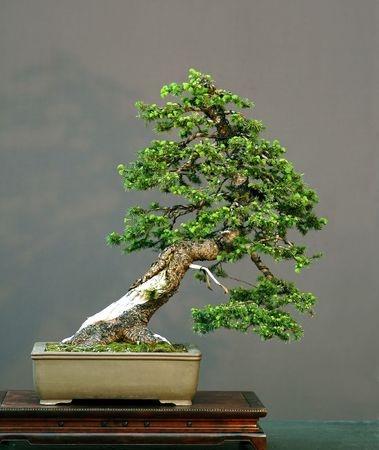
Even though a spruce bonsai can take a fair amount of work and patience to deal with, if properly styled it can grow to be one of the most sublime and majestic bonsai trees ever seen. Their natural cone shaped growth pattern makes it difficult to style and create a new ramification, and they certainly don’t backbud or get wired easily, thus making it hard to style into a wind-swept bonsai. They are some of the most popular bonsai trees in Japan, where they’re highly appreciated for their vigor and asperity. The Ezo spruce specie (Picea jezoensis) is particularly popular there for Saikei, but it can be hard to bring in to western countries due to export rules.
The spruce tree, in its natural habitat, is a large tree that can grow up to 60 meters (approximately 200 feet). They come from the Pinaceae Family, genus Picea, that consist of approximately 35 species, with origins in North America, Canada or Northern Europe. Some of the most common are known to be the Norway spruce (Picea abies), also known as the European spruce, the white spruce (Picea glauca) and the blue spruce (Picea pungens).

These coniferous evergreen trees can easily be distinguished by their conical form and their needle like waxy leaves, of a green to silver color. They’re brown to light grey bark is scaling and they hold pendent woody cones. They are popularly used as Christmas trees.
Because some species are slow-growing, they can be used as shrubs and can easily be grown into a bonsai tree.
Positioning – Although spruce trees naturally thrive in cooler climates, the bonsai tree does require a lot of direct sunlight. Be careful with the very hot summer period though, and make sure to shade them during intense midday times. It is and outdoor tree that can be kept outside year round, and although it likes cold weather, it needs to be protected from freezing temperatures.
Soil, Fertilizing and Watering – The soil must be kept moist at all times and never let to dry out, but be careful to not oversaturate it either. It needs to be watered more often during summer time, and not so much during winter. You can mist the dense foliage, especially during spring and fall. Be aware that any foliar insecticide can destroy their wax coating.
The soil needs to be supplemented often and enriched with liquefied special bonsai food. Soil fertilizing is a must through the entire growth period.
Pests and diseases: Spider mites are the most common problem for spruce bonsai. Because they can’t be seen with the naked eye, the way you can realize that you tree has a mite infection is when you see that the oldest needles are getting yellow at the base. You tree can also be attacked by needle casts, that makes needles turn yellow and drop off.
Styling is best carried out from late summer to fall. Because you don’t want to end up with a tree that has a few leaves only on the tips, best branches to be kept are the ones that have foliage closest to the trunk. Backbudding is very limited, especially when it comes to old branches and the trunk.
Wiring – it needs to be done after the tree has stopped its active growth, and best done in winter or even late autumn. Although the branches are very supple, you need to use thick wires so that they don’t snap when bent. Mature branches that have been wired can sometimes take years until they set into the new position, and even need rewiring at times.
Pruning – It is best to be done in autumn, as less resin will bleed out. Be careful not to pinch the needles too early. After the shoots have somewhat matured, pinch for about half of their length. Prune older branches, so that the younger ones can go into the empty spaces left.
Repotting: needs to be done every other year, either in spring or autumn.
The Picea genius has some excellent attributes, and you can find quite a few distinguished specimens all over the world. One of the most beautiful species out there is the Blue spruce, a beautiful conifer with a delightful blue-gray color, that is native to northern America and Canada. Its crown becomes cylindrical in shape as matures. The Ezo spruce is pretty similar, but its foliage is a lot greener, and has a slender conical shape. A distinctive and adored species is the white spruce, which has a strong and refreshing aroma. It has sharp blue-green needles and green cones that turn brown when matured.
The hardy and amazingly beautiful Norway spruce, with shiny green needles, is the most common one to use as a Christmas tree. It is very reliable and disease resistant. Somewhere in the Swedish mountains, scientists have found a Norway spruce tree that has reached an age of 9,550 years and is, allegedly, the oldest living tree in the world.
The dwarf Alberta spruce (Picea glauca conica) has a beautiful rich dark green foliage, and their cones have a very distinctive camphor smell if you crush them. Though not very often seen, they look amazing when trimmed into a spiral shape.